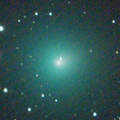
|
It approached to Earth down to 0.08 a.u. in mid December, and it brightened up to 3.4 mag (Dec. 14, Seiichi Yoshida). it looked so large as 3 times of Moon. Now it is fading. But it is bright as 6.9 mag still now (Jan. 21, Maik Meyer). In the Northern Hemisphere, it stays observable in excellent condition. In the Southern Hemisphere, it is not observable until February.
Date(TT) R.A. (2000) Decl. Delta r Elong. m1 Best Time(A, h)
Jan. 26 9 17.78 56 34.9 0.271 1.208 141 6.7 0:59 (180, 68)
Feb. 2 9 25.90 54 37.3 0.321 1.254 142 7.4 0:40 (180, 70)
|

|
Bright new comet. Now it is very bright as 9.3 mag (Jan. 21, Marco Goiato). It will approach to Earth down to 0.3 a.u. in February. Then it will brighten up to 7 mag and will be observable in excellent condition.
Date(TT) R.A. (2000) Decl. Delta r Elong. m1 Best Time(A, h)
Jan. 26 13 36.70 -18 21.8 0.746 1.299 96 9.0 5:18 ( 0, 36)
Feb. 2 12 57.00 -12 11.3 0.516 1.289 114 8.2 4:12 ( 0, 42)
|
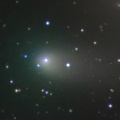
|
It brightened up to 9.5 mag from autumn to winter (Dec. 14, Marco Goiato). Now it is fading. But it is bright as 11.0 mag still now (Jan. 21, Maik Meyer). In the Northern Hemisphere, it stays observable in good condition for a long time until it fades out. It locates low in the Southern Hemispehre.
Date(TT) R.A. (2000) Decl. Delta r Elong. m1 Best Time(A, h)
Jan. 26 8 30.31 46 42.3 0.920 1.849 152 11.0 0:13 (180, 78)
Feb. 2 8 28.11 47 18.1 0.980 1.894 149 11.4 23:39 (180, 78)
|
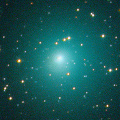
|
It brightened up to 9.0 mag from autumn to winter (Nov. 16, Maik Meyer). Now it is fading. But it is bright as 9.8 mag still now (Jan. 14, Juan Jose Gonzalez). It is observable in excellent condition in the Northern Hemisphere. It stays low in the Southern Hemisphere.
Date(TT) R.A. (2000) Decl. Delta r Elong. m1 Best Time(A, h)
Jan. 26 3 56.37 27 16.6 1.011 1.701 116 11.1 19:36 ( 0, 82)
Feb. 2 4 12.17 26 44.6 1.105 1.747 113 11.6 19:24 ( 0, 82)
|

|
It brightened up to 7.7 mag in June (June 19, Juan Jose Gonzalez). Now it is fading. But it is still bright as 10.9 mag (Jan. 14, Chris Wyatt). In the Southern Hemisphere, it stays observable in good condition for a long time until the comet will fade out. In the Northern Hemisphere, it is not observable for a long time until autumn when the comet fades out down to 16 mag.
Date(TT) R.A. (2000) Decl. Delta r Elong. m1 Best Time(A, h)
Jan. 26 2 18.90 -78 6.0 3.085 2.915 70 11.3 18:49 ( 3,-23)
Feb. 2 2 43.33 -74 51.7 3.108 2.964 72 11.4 18:55 ( 4,-20)
|
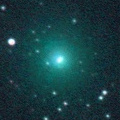
|
Now it is 10.4 mag (Jan. 3, Ken Harikae). It stays at 11 mag until February. In the Northern Hemisphere, it stays observable for a long time until it fades out. But it stays extremely low. It will never be observable again in the Southern Hemisphere.
Date(TT) R.A. (2000) Decl. Delta r Elong. m1 Best Time(A, h)
Jan. 26 20 15.45 27 29.8 2.386 1.852 46 11.6 5:35 (244, 12)
Feb. 2 20 39.23 29 50.8 2.415 1.888 47 11.8 5:32 (242, 13)
|

|
Now it is 13.7 mag (Jan. 2, Toshihiko Ikemura, Hirohisa Sato). It stays at 12-13 mag for a long time until autumn.
Date(TT) R.A. (2000) Decl. Delta r Elong. m1 Best Time(A, h)
Jan. 26 23 39.94 -0 47.9 2.585 2.086 49 12.6 18:49 ( 66, 30)
Feb. 2 23 53.98 0 26.3 2.628 2.072 46 12.6 18:55 ( 70, 27)
|

|
Now it is 11.9 mag (Dec. 31, Seiichi Yoshida). It stays 12 mag for a long time until spring.
Date(TT) R.A. (2000) Decl. Delta r Elong. m1 Best Time(A, h)
Jan. 26 6 26.56 -21 55.9 2.612 3.321 129 12.9 22:04 ( 0, 33)
Feb. 2 6 14.16 -22 12.4 2.717 3.363 123 13.0 21:24 ( 0, 33)
|

|
Now it is 15.3 mag (Jan. 3, Toshihiko Ikemura, Hirohisa Sato). It will be fading slowly after this. It is observable in good condition in the Northern Hemisphere. In the Southern Hemisphere, it is not observable until summer.
Date(TT) R.A. (2000) Decl. Delta r Elong. m1 Best Time(A, h)
Jan. 26 15 50.49 41 49.9 3.626 3.736 88 13.2 5:35 (245, 66)
Feb. 2 15 55.70 42 23.6 3.627 3.785 91 13.2 5:32 (242, 70)
|
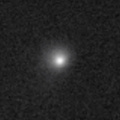
|
Now it is 13.9 mag (Dec. 28, Chris Wyatt). It will brighten up to 10-11 mag in autumn. It will be unobservable temporarily in March.
Date(TT) R.A. (2000) Decl. Delta r Elong. m1 Best Time(A, h)
Jan. 26 1 3.31 -27 23.8 4.517 4.153 62 13.5 18:49 ( 30, 21)
Feb. 2 1 4.84 -25 31.4 4.562 4.111 57 13.4 18:55 ( 38, 19)
|

|
Now it is bright as 12.9 mag (Jan. 2, Toshihiko Ikemura, Hirohisa Sato).
Date(TT) R.A. (2000) Decl. Delta r Elong. m1 Best Time(A, h)
Jan. 26 23 13.63 1 26.5 6.424 5.767 44 13.7 18:49 ( 72, 26)
Feb. 2 23 18.27 1 55.1 6.500 5.767 38 13.8 18:55 ( 78, 20)
|
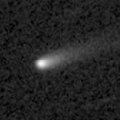
|
Now it is 13.8 mag (Jan. 12, Chris Wyatt). It is observable at 14 mag in excellent condition until March.
Date(TT) R.A. (2000) Decl. Delta r Elong. m1 Best Time(A, h)
Jan. 26 11 44.14 -4 51.4 0.897 1.684 126 13.9 3:25 ( 0, 50)
Feb. 2 11 46.71 -5 37.8 0.871 1.703 133 13.9 3:01 ( 0, 49)
|

|
Now it is 12.6 mag (Jan. 21, Sandor Szabo). It is observable in excellent condition in the Northern Hemisphere. It locates low in the Southern Hemisphere.
Date(TT) R.A. (2000) Decl. Delta r Elong. m1 Best Time(A, h)
Jan. 26 11 40.29 29 44.9 1.308 2.128 135 14.0 3:22 ( 0, 85)
Feb. 2 11 40.52 30 23.7 1.268 2.127 141 13.9 2:54 ( 0, 85)
|

|
Now it is 13.9 mag (Jan. 19, Martin Masek). It stays 13-14 mag until summer.
Date(TT) R.A. (2000) Decl. Delta r Elong. m1 Best Time(A, h)
Jan. 26 17 23.77 -14 40.1 3.874 3.253 44 14.1 5:35 (305, 20)
Feb. 2 17 26.84 -15 52.6 3.784 3.255 50 14.0 5:32 (310, 22)
|

|
Now it is 14.6 mag (Jan. 10, Toshihiko Ikemura, Hirohisa Sato). It will be fading slowly after this. It is observable in excellent condition until spring in the Northern Hemispehre. In the Southern Hemisphere, it will be hardly observable after this.
Date(TT) R.A. (2000) Decl. Delta r Elong. m1 Best Time(A, h)
Jan. 26 10 59.11 42 49.6 3.962 4.765 140 14.4 2:41 (180, 82)
Feb. 2 10 46.16 43 30.3 3.959 4.802 145 14.5 2:01 (180, 82)
|

|
Now it is 14.3 mag (Nov. 30, Seiichi Yoshida). It stays at 14 mag until winter. It is observable in excellent condition in the Northern Hemisphere. In the Southern Hemisphere, it is not observable until summer.
Date(TT) R.A. (2000) Decl. Delta r Elong. m1 Best Time(A, h)
Jan. 26 12 48.01 81 11.6 1.568 2.147 112 14.6 4:30 (180, 44)
Feb. 2 12 8.80 81 21.9 1.596 2.177 112 14.6 3:24 (180, 44)
|
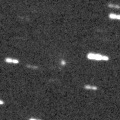
|
Now it is bright as 14.8 mag (Dec. 12, Kunihiro Shima). It stays 14 mag for a long time in 2019. In the Southern Hemisphere, it is observable in excellent condition. In the Northern Hemisphere, it is not observasble until summer in 2020.
Date(TT) R.A. (2000) Decl. Delta r Elong. m1 Best Time(A, h)
Jan. 26 11 4.86 -50 32.1 3.006 3.363 102 14.7 2:47 ( 0, 4)
Feb. 2 10 52.96 -52 59.0 2.930 3.337 105 14.6 2:07 ( 0, 2)
|

|
Now it is 14.5 mag (Aug. 16, P. Camilleri, H. Williams). It stays 15 mag from 2018 to 2019, and it will be observable for a long time in the Southern Hemisphere. In the Northern Hemisphere, it will never be observable again.
Date(TT) R.A. (2000) Decl. Delta r Elong. m1 Best Time(A, h)
Jan. 26 21 3.22 -61 34.7 4.583 3.922 43 14.9 18:49 ( 34,-31)
Feb. 2 21 21.45 -60 22.4 4.577 3.921 43 14.9 18:55 ( 36,-32)
|
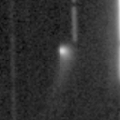
|
Now it is 14.6 mag (Jan. 21, Sandor Szabo). It stays 15 mag until March. It is observable in excellent condition in the Northern Hemisphere. It is not observable at all in the Southern Hemisphere.
Date(TT) R.A. (2000) Decl. Delta r Elong. m1 Best Time(A, h)
Jan. 26 6 26.04 76 14.1 2.668 3.279 120 15.3 22:01 (180, 49)
Feb. 2 5 24.18 74 28.0 2.733 3.282 115 15.3 20:33 (180, 51)
|
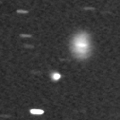
|
Now it is 15.4 mag (Jan. 2, Toshihiko Ikemura, Hirohisa Sato). It is expected to brighten up to 7-8 mag in 2020. It will be unobservable temporarily in April.
Date(TT) R.A. (2000) Decl. Delta r Elong. m1 Best Time(A, h)
Jan. 26 2 59.42 -1 59.6 5.250 5.442 95 15.5 18:49 ( 4, 53)
Feb. 2 2 58.79 -1 15.7 5.302 5.381 89 15.4 18:55 ( 19, 52)
|

|
Although it was faint as 16-17 mag in November, it brightened up to 14.7 mag in December (Dec. 12, Toshihiko Ikemura, Hirohisa Sato). Now it is 15.5 mag (Jan. 21, Sandor Szabo). In the Northern Hemisphere, it stays observable in excellent condition after this. It stays extremely low in the Southern Hemisphere.
Date(TT) R.A. (2000) Decl. Delta r Elong. m1 Best Time(A, h)
Jan. 26 11 23.72 38 49.4 2.036 2.844 137 15.7 3:05 (180, 86)
Feb. 2 11 20.15 40 2.0 2.033 2.874 142 15.9 2:34 (180, 85)
|

|
It brightened up to 6.8 mag in September (Sept. 17, Seiichi Yoshida). Now it is fading rapidly. It has already faded down to 13.8 mag (Jan. 6, Toshihiko Ikemura, Hirohisa Sato). It is observable in excellent condition in the Southern Hemisphere. It locates low after this in the Northern Hemisphere.
Date(TT) R.A. (2000) Decl. Delta r Elong. m1 Best Time(A, h)
Jan. 26 6 5.77 -29 34.7 1.335 2.018 120 16.0 21:44 ( 0, 26)
Feb. 2 6 4.77 -27 4.8 1.420 2.081 118 16.4 21:15 ( 0, 28)
|
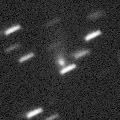
|
It brightened up to 8.7 mag in July (July 18, Marco Goiato). Then it faded down to 12.3 mag in August (Aug. 29, Chris Wyatt). It stays observable in good condition after this while the comet will be fading.
Date(TT) R.A. (2000) Decl. Delta r Elong. m1 Best Time(A, h)
Jan. 26 16 20.79 -17 52.2 3.419 3.033 59 16.5 5:35 (321, 27)
Feb. 2 16 24.04 -16 59.8 3.391 3.116 65 16.6 5:32 (325, 30)
|

|
First return of a new periodic comet discovered in 2014. It has not been recovered yet. Now it is not detected, fainter than 20.0 mag (Dec. 10, Toshihiko Ikemura, Hirohisa Sato). The condition of this apparition is excelllent. It will brighten rapidly, and will be observable at 15.5 mag in excellent condition in March.
Date(TT) R.A. (2000) Decl. Delta r Elong. m1 Best Time(A, h)
Jan. 26 10 29.94 6 56.1 0.997 1.908 148 16.8 2:12 ( 0, 62)
Feb. 2 10 28.99 7 11.0 0.938 1.882 156 16.6 1:43 ( 0, 62)
|

|
It is expected to brighten up to 10 mag in autumn. Now it is 17.2 mag (Dec. 31, Toshihiko Ikemura, Hirohisa Sato). In the Northern Hemisphere, it stays observable for a long time while the comet is brightening. In the Southern Hemisphere, it it not observable until mid September.
Date(TT) R.A. (2000) Decl. Delta r Elong. m1 Best Time(A, h)
Jan. 26 14 12.40 65 35.9 2.757 3.217 109 16.8 5:35 (184, 59)
Feb. 2 14 22.57 69 20.2 2.681 3.146 109 16.6 5:32 (181, 56)
|

|
Now it is 16.4 mag (Jan. 6, Toshihiko Ikemura, Hirohisa Sato). It stays 16-17 mag for a long time until 2020. It is observable in good condition in the Northern Hemisphere. It is not observable at all in the Southern Hemisphere.
Date(TT) R.A. (2000) Decl. Delta r Elong. m1 Best Time(A, h)
Jan. 26 11 55.76 73 13.1 7.929 8.448 118 16.6 3:37 (180, 52)
Feb. 2 11 52.24 73 36.4 7.931 8.447 118 16.6 3:06 (180, 52)
|

|
Now it is 16.5 mag (Jan. 3, Toshihiko Ikemura, Hirohisa Sato). It is observable at 16.5 mag in good condition in winter.
Date(TT) R.A. (2000) Decl. Delta r Elong. m1 Best Time(A, h)
Jan. 26 4 25.91 17 27.9 1.046 1.776 122 16.8 20:05 ( 0, 73)
Feb. 2 4 31.52 20 3.1 1.106 1.781 116 17.0 19:43 ( 0, 75)
|
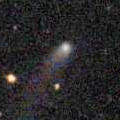
|
It brightened up to 14.7 mag in early 2018 (Jan. 25, Catalina Sky Survey). Now it is fading slowly. Now it is 16.4 mag (Jan. 3, Toshihiko Ikemura, Hirohisa Sato). In the Northern Hemisphere, it stays observable in good condition for a long time until the comet fades out. It is never observable again in the Southern Hemisphere.
Date(TT) R.A. (2000) Decl. Delta r Elong. m1 Best Time(A, h)
Jan. 26 5 8.76 72 37.7 5.651 6.192 119 16.8 20:47 (180, 52)
Feb. 2 4 51.97 72 7.1 5.742 6.217 114 16.9 20:03 (180, 53)
|
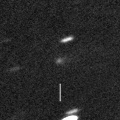
|
Now it is 17.0 mag (Dec. 31, Toshihiko Ikemura, Hirohisa Sato). It stays observable at 17 mag in good condition until February. It locates somewhat low in the Southern Hemisphere.
Date(TT) R.A. (2000) Decl. Delta r Elong. m1 Best Time(A, h)
Jan. 26 8 8.51 23 11.1 1.581 2.561 173 16.9 23:46 ( 0, 78)
Feb. 2 8 3.01 22 54.2 1.616 2.582 165 17.0 23:13 ( 0, 78)
|
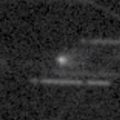
|
Now it is 17.0 mag (Jan. 6, Toshihiko Ikemura, Hirohisa Sato). It is observable at 17 mag in good condition in winter. It locates low in the Southern Hemisphere.
Date(TT) R.A. (2000) Decl. Delta r Elong. m1 Best Time(A, h)
Jan. 26 11 17.03 27 3.5 1.855 2.693 141 17.1 2:59 ( 0, 82)
Feb. 2 11 12.88 28 15.0 1.850 2.733 147 17.2 2:27 ( 0, 83)
|
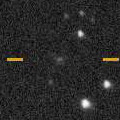
|
Now it is 17.4 mag (Jan. 3, Toshihiko Ikemura, Hirohisa Sato). It stays 16 mag for a long time from 2019 to 2020. It is observable in excellent condition in the Southern Hemisphere. It is hardly observable in the Northern Hemisphere.
Date(TT) R.A. (2000) Decl. Delta r Elong. m1 Best Time(A, h)
Jan. 26 14 17.96 -40 42.0 4.511 4.451 80 17.3 5:35 (355, 14)
Feb. 2 14 18.08 -42 22.3 4.370 4.413 86 17.1 5:32 ( 0, 13)
|

|
Now it is 17.1 mag (Dec. 31, Toshihiko Ikemura, Hirohisa Sato). Fading slowly. It stays observable at 17 mag in good condition until summer.
Date(TT) R.A. (2000) Decl. Delta r Elong. m1 Best Time(A, h)
Jan. 26 11 43.31 6 45.3 9.271 9.955 131 17.2 3:25 ( 0, 62)
Feb. 2 11 42.69 7 2.1 9.200 9.966 139 17.2 2:57 ( 0, 62)
|

|
Now it is 16.5 mag (Jan. 10, Toshihiko Ikemura, Hirohisa Sato). It is observable at 17 mag in good condition in 2019. It locates somewhat low in the Northern Hemisphere.
Date(TT) R.A. (2000) Decl. Delta r Elong. m1 Best Time(A, h)
Jan. 26 15 32.03 -15 10.1 3.950 3.748 71 17.3 5:35 (331, 35)
Feb. 2 15 37.67 -15 29.3 3.856 3.756 76 17.3 5:32 (336, 36)
|
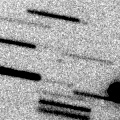
|
Now it is 17.8 mag (Jan. 5, Toshihiko Ikemura, Hirohisa Sato). It is observable at 17 mag in good condition in winter in the Northern Hemisphere. It locates very low in the Southern Hemisphere.
Date(TT) R.A. (2000) Decl. Delta r Elong. m1 Best Time(A, h)
Jan. 26 11 26.00 37 32.5 0.736 1.607 137 17.3 3:07 (180, 88)
Feb. 2 11 24.98 38 8.9 0.744 1.637 141 17.4 2:39 (180, 87)
|

|
Now it is 16.3 mag (Jan. 6, Toshihiko Ikemura, Hirohisa Sato). It is expected to be observable at 5-6 mag for a long time from 2022 to 2023. It will be observable in good condition for a long time in the Southern Hemisphere. In the Northern Hemisphere, it is not observable at the highlight from 2022 summer to 2023 summer.
Date(TT) R.A. (2000) Decl. Delta r Elong. m1 Best Time(A, h)
Jan. 26 17 59.37 52 1.6 12.545 12.382 78 17.4 5:35 (229, 44)
Feb. 2 18 2.28 52 16.0 12.483 12.338 79 17.4 5:32 (228, 47)
|
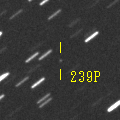
|
Now it is 17.2 mag (Dec. 31, Toshihiko Ikemura, Hirohisa Sato). It is observable at 17.5 mag in excellent condition in January.
Date(TT) R.A. (2000) Decl. Delta r Elong. m1 Best Time(A, h)
Jan. 26 8 8.25 -1 4.4 0.700 1.658 159 17.4 23:46 ( 0, 54)
Feb. 2 8 6.26 -1 52.9 0.715 1.667 156 17.5 23:17 ( 0, 53)
|
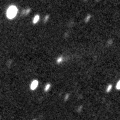
|
Now it is 16.7 mag (Jan. 5, Toshihiko Ikemura, Hirohisa Sato). It is observable in good condition at 16-17 mag in winter.
Date(TT) R.A. (2000) Decl. Delta r Elong. m1 Best Time(A, h)
Jan. 26 6 55.87 2 58.0 2.203 3.106 151 17.6 22:34 ( 0, 58)
Feb. 2 6 52.72 3 25.7 2.261 3.126 145 17.7 22:03 ( 0, 58)
|

|
Now it is 17.2 mag (Dec. 31, Toshihiko Ikemura, Hirohisa Sato). It was observed at 17 mag in last winter. It will be observable in good condition at 17.5 mag also in this winter.
Date(TT) R.A. (2000) Decl. Delta r Elong. m1 Best Time(A, h)
Jan. 26 4 29.46 4 1.8 7.573 8.099 119 17.6 20:08 ( 0, 59)
Feb. 2 4 26.20 3 57.4 7.692 8.108 111 17.6 19:37 ( 0, 59)
|
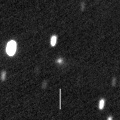
|
Now it is 16.9 mag (Dec. 31, Toshihiko Ikemura, Hirohisa Sato). It is observable at 17.5 mag until January, in good condition in the Northern Hemisphere. It locates very low in the Southern Hemisphere.
Date(TT) R.A. (2000) Decl. Delta r Elong. m1 Best Time(A, h)
Jan. 26 5 48.74 43 57.0 3.087 3.873 137 17.7 21:27 (180, 81)
Feb. 2 5 46.15 43 51.3 3.165 3.887 131 17.7 20:57 (180, 81)
|

|
Now it is 17.9 mag (Jan. 3, Toshihiko Ikemura, Hirohisa Sato). It stays 17 mag from spring to summer. But it is hardly observable. In the Northern Hemisphere, it is observable only until May. In the Southern Hemisphere, it stays locating extremely low.
Date(TT) R.A. (2000) Decl. Delta r Elong. m1 Best Time(A, h)
Jan. 26 3 40.63 49 3.5 2.260 2.826 115 17.8 19:20 (180, 76)
Feb. 2 3 44.31 48 7.2 2.282 2.777 109 17.7 18:56 (180, 77)
|

|
It was expected to be observable at 17.5 mag in good condition in winter in the Northern Hemisphere. But actually, it is so faint as 19.7 mag (Dec. 29, Kunihiro Shima). It locates low in the Southern Hemisphere.
Date(TT) R.A. (2000) Decl. Delta r Elong. m1 Best Time(A, h)
Jan. 26 5 9.17 34 58.2 2.256 3.012 132 17.7 20:48 ( 0, 90)
Feb. 2 5 8.44 34 58.8 2.323 3.007 125 17.8 20:20 (180, 90)
|
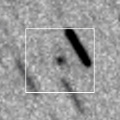
|
Now it is 17.6 mag (Dec. 31, Toshihiko Ikemura, Hirohisa Sato). First return of a new periodic comet which brightened up to 16 mag in 2011. It is observable at 17.5 mag in good condition in winter.
Date(TT) R.A. (2000) Decl. Delta r Elong. m1 Best Time(A, h)
Jan. 26 2 54.49 11 36.7 2.005 2.370 99 17.8 18:49 ( 9, 66)
Feb. 2 3 1.67 11 44.7 2.081 2.360 93 17.8 18:55 ( 25, 65)
|

|
Now it is 17.5 mag (Jan. 19, Catalina Sky Survey). In the Northern Hemisphere, it is observable at 17.5 mag in good condition in February. It is not observable in the Southern Hemisphere.
Date(TT) R.A. (2000) Decl. Delta r Elong. m1 Best Time(A, h)
Jan. 26 13 5.31 62 36.9 1.076 1.753 116 18.1 4:48 (180, 63)
Feb. 2 11 37.50 69 59.7 0.980 1.718 121 17.8 2:56 (180, 55)
|

|
Now it is 18.8 mag (Jan. 2, Toshihiko Ikemura, Hirohisa Sato). It will brighten up to 16 mag in spring. But the condition is bad. In the Northern Hemisphre, it is observable only until March. It stays low even in the Southern Hemisphere.
Date(TT) R.A. (2000) Decl. Delta r Elong. m1 Best Time(A, h)
Jan. 26 1 33.75 8 2.3 1.921 1.988 79 17.9 18:49 ( 45, 55)
Feb. 2 1 38.35 5 33.2 1.978 1.923 72 17.8 18:55 ( 52, 49)
|
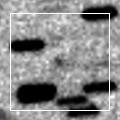
|
Now it is 17.9 mag (Dec. 31, Toshihiko Ikemura, Hirohisa Sato). It is observable at 18 mag in winter.
Date(TT) R.A. (2000) Decl. Delta r Elong. m1 Best Time(A, h)
Jan. 26 6 34.44 22 16.6 2.584 3.487 152 17.9 22:13 ( 0, 77)
Feb. 2 6 31.01 22 27.6 2.632 3.482 144 17.9 21:42 ( 0, 77)
|

|
Now it is 17.9 mag (Jan. 3, Toshihiko Ikemura, Hirohisa Sato). It is observable at 18 mag in good condition from January to February. It locates low in the Southern Hemisphere.
Date(TT) R.A. (2000) Decl. Delta r Elong. m1 Best Time(A, h)
Jan. 26 10 47.82 32 13.2 1.029 1.929 146 17.9 2:30 ( 0, 87)
Feb. 2 10 43.12 31 34.6 1.015 1.943 152 17.9 1:57 ( 0, 87)
|
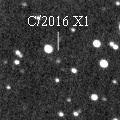
|
Now it is 17.8 mag (Jan. 6, Toshihiko Ikemura, Hirohisa Sato). It is observable at 18 mag in winter.
Date(TT) R.A. (2000) Decl. Delta r Elong. m1 Best Time(A, h)
Jan. 26 7 14.34 3 54.2 6.677 7.586 155 17.9 22:52 ( 0, 59)
Feb. 2 7 12.31 3 52.7 6.710 7.583 150 17.9 22:23 ( 0, 59)
|

|
Main-belt asteroid. But it shows a straight tail like a comet. Now it is 17.2 mag (Jan. 12, Toshihiko Ikemura, Hirohisa Sato). It stays observable in excellent condition until early summer.
Date(TT) R.A. (2000) Decl. Delta r Elong. m1 Best Time(A, h)
Jan. 26 10 45.96 -12 28.0 1.643 2.435 134 18.3 2:28 ( 0, 42)
Feb. 2 10 42.77 -11 58.1 1.571 2.421 141 18.1 1:57 ( 0, 43)
|
|
![]()
 C/2018 A6 ( Gibbs )
C/2018 A6 ( Gibbs ) C/2017 B3 ( LINEAR )
C/2017 B3 ( LINEAR ) C/2018 A3 ( ATLAS )
C/2018 A3 ( ATLAS ) C/2017 T2 ( PanSTARRS )
C/2017 T2 ( PanSTARRS ) 240P/NEAT
240P/NEAT 21P/Giacobini-Zinner
21P/Giacobini-Zinner C/2017 T3 ( ATLAS )
C/2017 T3 ( ATLAS ) P/2014 C1 ( TOTAS )
P/2014 C1 ( TOTAS ) C/2018 W2 ( Africano )
C/2018 W2 ( Africano ) C/2010 U3 ( Boattini )
C/2010 U3 ( Boattini ) 171P/Spahr
171P/Spahr C/2016 A1 ( PanSTARRS )
C/2016 A1 ( PanSTARRS ) 59P/Kearns-Kwee
59P/Kearns-Kwee 164P/Christensen
164P/Christensen C/2018 F4 ( PanSTARRS )
C/2018 F4 ( PanSTARRS ) C/2014 B1 ( Schwartz )
C/2014 B1 ( Schwartz ) 74P/Smirnova-Chernykh
74P/Smirnova-Chernykh 247P/LINEAR
247P/LINEAR C/2017 K2 ( PanSTARRS )
C/2017 K2 ( PanSTARRS ) 239P/LINEAR
239P/LINEAR 361P/2017 S4 ( Spacewatch )
361P/2017 S4 ( Spacewatch ) C/2015 XY1 ( Lemmon )
C/2015 XY1 ( Lemmon ) 159P/LONEOS
159P/LONEOS C/2018 X2 ( Fitzsimmons )
C/2018 X2 ( Fitzsimmons ) 232P/Hill
232P/Hill 373P/2018 R2 ( Rinner )
373P/2018 R2 ( Rinner ) C/2019 B1 ( Africano )
C/2019 B1 ( Africano ) C/2018 W1 ( Catalina )
C/2018 W1 ( Catalina ) 31P/Schwassmann-Wachmann 2
31P/Schwassmann-Wachmann 2 375P/2018 T1 ( Hill )
375P/2018 T1 ( Hill ) C/2016 X1 ( Lemmon )
C/2016 X1 ( Lemmon ) (6478) Gault
(6478) Gault![]()







































